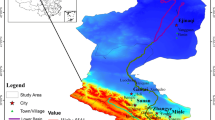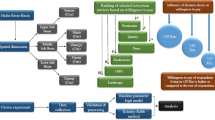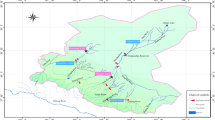Abstract
Valuation of environmental goods and services are frequently spatially heterogeneous, the significance of this heterogeneity for policy analysis is gradually recognized. For the valuation of environmental goods and services in the context of attaining a better environmental status across Heihe River basin (HRB), Northwest of China by 2020, a survey was conducted employing choice experiment approach across the entire river basin. In this research we estimate the impact of distance from inland rivers’ origin (spatial attribute) on the inhabitants’ willingness to pay for restoration of ecological attributes. A total of 11 ecological attributes were selected including 6 land related attributes and 5 water related attributes. The present study displays the outcomes of the research planned to examine differences in willingness to pay across different locations/distances. A total of five cities and 33 surround villages/townships were included to examine for location effect, while four ad hoc base distances split samples were recognized for distance effect i.e. ≤100 km, ≤200 km, ≤300 and > 300 km from rivers’ origin. The results of mixed logit model recognized that people living at different locations value the attributes differently. For instance the people of Zhangye region are willing to pay RMB 95.66 annually for improvements in biodiversity while in Gaotai the individuals’ willingness to pay (WTP) for the same attributes was RMB 45.68. Similarly, the respondents’ living nearer to the origin of river were willing to pay relatively higher amount for the upgradation in the degraded ecosystem services than the remainders. The results of willingness to pay obtained by Krinsky Robb method confirmed that the attributes quality of agricultural products and water quality were the most preferred attributes with the willingness to pay RMB 91.09 and 122.89 respectively. The significant results of willingness to pay may serve as a reference for sustainable improvements and uplifting of the degraded ecological attributes.


Similar content being viewed by others
References
Bach MF, Beckmann MJ (1999) Lectures on location theory. Springer Science & Business Media
Bakhtiari F, Jacobsen JB, Thorsen BJ, Lundhede TH, Strange N, Boman M (2018) Disentangling distance and country effects on the value of conservation across National Borders. Ecol Econ 147:11–20
Bateman IJ, Jones AP, Lovett AA, Lake IR, Day B (2002) Applying geographical information systems (GIS) to environmental and resource economics. Environ Resour Econ 22:219–269
Bateman IJ, Cooper P, Georgiou S, Navrud S, Poe GL, Ready RC, Riera P, Ryan M, Vossler CA (2005) Economic valuation of policies for managing acidity in remote mountain lakes: examining validity through scope sensitivity testing. Aquat Sci 67:274–291
Bateman IJ, Day BH, Georgiou S, Lake I (2006) The aggregation of environmental benefit values: welfare measures, distance decay and total WTP. Ecol Econ 60:450–460
Bateman I, Brouwer R, Ferrini S, Schaafsma M, Barton DN, Dubgaard A, Hasler B, Hime S, Liekens I, Navrud S (2011) Making benefit transfers work: deriving and testing principles for value transfers for similar and dissimilar sites using a case study of the non-market benefits of water quality improvements across Europe. Environ Resour Econ 50:365–387
Ben-Akiva ME, Lerman SR, Lerman SR (1985) Discrete choice analysis: theory and application to travel demand. MIT press
Bockstael NE, Hanemann WM, Kling CL (1987) Estimating the value of water quality improvements in a recreational demand framework. Water Resour Res 23:951–960
Brouwer R, Spaninks FA (1999) The validity of environmental benefits transfer: further empirical testing. Environ Resour Econ 14:95–117
Brouwer R, Martin-Ortega J, Berbel J (2010) Spatial preference heterogeneity: a choice experiment. Land Econ 86:552–568
Chen WY, Hua J, Liekens I, Broekx S (2018) Preference heterogeneity and scale heterogeneity in urban river restoration: a comparative study between Brussels and Guangzhou using discrete choice experiments. Landsc Urban Plan 173:9–22
Cheng G-d, Xiao H, Xu Z, Li J, Lu M (2006) Water issue and its countermeasure in the Inland River basins of Northwest China: a case study in H eihe River Basin. J Glaciol Geocryol 3:016
Clawson M, Knetsch JL (2013) Economics of outdoor recreation. RFF Press
Czajkowski M, Budziński W, Campbell D, Giergiczny M, Hanley N (2017) Spatial heterogeneity of willingness to pay for Forest management. Working Papers 68:1–23
Dallimer M, Jacobsen JB, Lundhede TH, Takkis K, Giergiczny M, Thorsen BJ (2014) Patriotic values for public goods: transnational trade-offs for biodiversity and ecosystem services? Bioscience 65:33–42
Espey M, Owusu-Edusei K (2001) Neighborhood parks and residential property values in Greenville, South Carolina. J Agric Appl Econ 33:487–492
Gao Q-z, Li F-x (1991) Case study of rational development and utilization of water resources in the Heihe River basin. Gansu Science and Technology Press, Lanzhou, pp 1–228
Glenk K, Johnston RJ, Meyerhoff J, Sagebiel J (2019) Spatial dimensions of stated preference valuation in environmental and resource economics: methods, trends and challenges. Environ Resour Econ:1–28
Greene WH, Hensher DA (2007) Heteroscedastic control for random coefficients and error components in mixed logit. Transp Res E 43:610–623
Hanley N, Wright RE, Koop G (2002) Modelling recreation demand using choice experiments: climbing in Scotland. Environ Resour Econ 22:449–466
Hanley N, Schläpfer F, Spurgeon J (2003) Aggregating the benefits of environmental improvements: distance-decay functions for use and non-use values. J Environ Manag 68:297–304
Hensher DA, Greene WH (2003) The mixed logit model: the state of practice. Transportation 30:133–176
Imber D, Stevenson G, Wilks LC (1991) A contingent valuation survey of the Kakadu conservation zone. Volume one. Australian Government Publishing Service for Resource Assessment Commission
Interis MG, Petrolia DR (2016) Location, location, habitat: how the value of ecosystem services varies across location and by habitat. Land Econ 92:292–307
Jacobsen JB, Thorsen BJ (2010) Preferences for site and environmental functions when selecting forthcoming national parks. Ecol Econ 69:1532–1544
Johnston RJ, Duke JM (2009) Willingness to pay for land preservation across states and jurisdictional scale: implications for benefit transfer. Land Econ 85:217–237
Johnston RJ, Opaluch JJ, Grigalunas TA, Mazzotta MJ (2001) Estimating amenity benefits of coastal farmland. Growth Chang 32:305–325
Khan I, Zhao M, Khan SU (2018) Ecological degradation of an inland river basin and an evaluation of the spatial and distance effect on willingness to pay for its improvement. Environ Sci Pollut Res 25:31474–31485
Khan I, Khan SU, Zhao M, Khan AA (2019a) Exploring the spatial heterogeneity of individual preferences for integrated river basin management: an example of Heihe river basin. Environ Sci Pollut Res:1–11
Khan SU, Khan I, Zhao M, Khan AA, Ali MAS (2019b) Valuation of ecosystem services using choice experiment with preference heterogeneity: a benefit transfer analysis across inland river basin. Sci Total Environ
Khan SU, Khan I, Zhao M, Khan AA, Ali MAS (2019c) Valuation of ecosystem services using choice experiment with preference heterogeneity: a benefit transfer analysis across inland river basin. Sci Total Environ 679:126–135
Kosenius A-K, Markku O (2015) Ecosystem benefits from coastal habitats—a three-country choice experiment. Mar Policy 58:15–27
Krinsky I, Robb AL (1986) On approximating the statistical properties of elasticities. Rev Econ Stat 68:715–719
Li F, Zhu G, Guo C (2013) Shiyang River ecosystem problems and countermeasures. Agric Sci 4:72–78
Loomis JB (1996) How large is the extent of the market for public goods: evidence from a nationwide contingent valuation survey. Appl Econ 28:779–782
Martin-Ortega J, Brouwer R, Ojea E, Berbel J (2012) Benefit transfer and spatial heterogeneity of preferences for water quality improvements. J Environ Manag 106:22–29
McFadden D, Train K (2000) Mixed MNL models for discrete response. J Appl Econ 15:447–470
Morrison M, Bennett J (2004) Valuing New South Wales rivers for use in benefit transfer. Aust J Agric Resour Econ 48:591–611
Morrison M, Bennett J, Blamey R, Louviere J (2002) Choice modeling and tests of benefit transfer. Am J Agric Econ 84:161–170
Pate J, Loomis J (1997) The effect of distance on willingness to pay values: a case study of wetlands and salmon in California. Ecol Econ 20:199–207
Paterson RW, Boyle KJ (2002) Out of sight, out of mind? Using GIS to incorporate visibility in hedonic property value models. Land Econ 78:417–425
Qi S, Luo F (2007) Environmental degradation problems in the Heihe River basin, Northwest China. Water Environ J 21:142–148
Revelt D, Train K (1998) Mixed logit with repeated choices: households' choices of appliance efficiency level. Rev Econ Stat 80:647–657
Rolfe J, Bennett J, Louviere J (2000) Choice modelling and its potential application to tropical rainforest preservation. Ecol Econ 35:289–302
Scarpa R, Ferrini S, Willis K (2005) Performance of error component models for status-quo effects in choice experiments. In: Applications of simulation methods in environmental and resource economics. Springer, pp 247–273
Scarpa R, Willis KG, Acutt M (2007) Valuing externalities from water supply: status quo, choice complexity and individual random effects in panel kernel logit analysis of choice experiments. J Environ Plan Manag 50:449–466
Scarpa R, Thiene M, Marangon F (2008) Using flexible taste distributions to value collective reputation for environmentally friendly production methods. Can J Agric Econ 56:145–162
Schaafsma M, Brouwer R, Gilbert A, van den Bergh J, Wagtendonk A (2013) Estimation of distance-decay functions to account for substitution and spatial heterogeneity in stated preference research. Land Econ 89:514–537
Shi H, Zhao M, Aregay FA, Zhao K, Jiang Z (2016) Residential environment induced preference heterogeneity for river ecosystem service improvements: a comparison between urban and rural households in the Wei River basin, China. Discret Dyn Nat Soc 2016:1–9
Sutherland RJ, Walsh RG (1985) Effect of distance on the preservation value of water quality. Land Econ 61:281–291
Train Kenneth E (2003) Discrete choice methods with simulation. Cambridge UniversityPress, Cambridge
Von Haefen RH, Phaneuf DJ (2008) Identifying demand parameters in the presence of unobservables: a combined revealed and stated preference approach. J Environ Econ Manag 56:19–32
Whitehead JC, Pattanayak SK, Van Houtven GL, Gelso BR (2008) Combining revealed and stated preference data to estimate the nonmarket value of ecological services: an assessment of the state of the science. J Econ Surv 22:872–908
Yao RT, Scarpa R, Turner JA, Barnard TD, Rose JM, Palma JH, Harrison DR (2014) Valuing biodiversity enhancement in New Zealand's planted forests: socioeconomic and spatial determinants of willingness-to-pay. Ecol Econ 98:90–101
Acknowledgements
The survey was sponsored by a major project supported by the National Social Science major Foundation of China (no. 15ZDA052) and Integrated Soil and Water Conservation Technology Research and Demonstration on Loess Plateau, National key R&D Program of China (no. 2016YFC0501707).
Author information
Authors and Affiliations
Corresponding authors
Additional information
Responsible editor: Philippe Garrigues
Publisher’s note
Springer Nature remains neutral with regard to jurisdictional claims in published maps and institutional affiliations.
Electronic supplementary material
ESM 1
(DOCX 90 kb)
Rights and permissions
About this article
Cite this article
Khan, S.U., Liu, G., Zhao, M. et al. Spatial prioritization of willingness to pay for ecosystem services. A novel notion of distance from origin’s impression. Environ Sci Pollut Res 27, 3100–3112 (2020). https://doi.org/10.1007/s11356-019-06538-4
Received:
Accepted:
Published:
Issue Date:
DOI: https://doi.org/10.1007/s11356-019-06538-4




